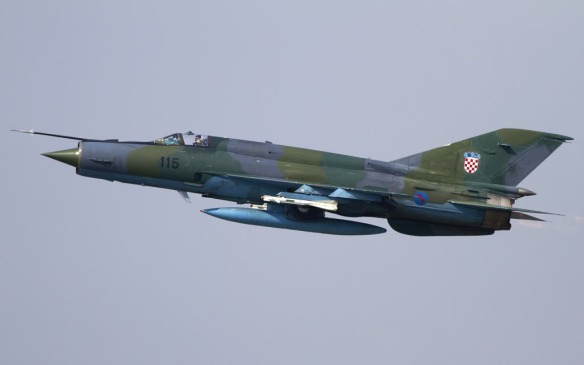MiG-21BIS-D, Croatia Air Force.
Martin Král
Towards the end of the sixties, the MiG design bureau embarked on a modification program of the design that subsequently was given the designation MiG-21BIS. It was an extension of the MiG-21SM, and as opposed to all previous members of the family, was optimized for air to air combat in tight maneuvering fights at low to medium altitudes.
The specifications issued would require the MiG-21BIS to undergo several structural changes that would separate it from its predecessors, the MiG-21SM and SMT. First and foremost, the uprated R-25-300 engine was installed, that could develop 9720kg of thrust. This was the final, and one could say ultimate, development of the R-11 that powered the first and second generation MiG-21s. Thanks to the more powerful engine, the climb rate rose to 225m/s as opposed to 120 to 130m/s in the SM powered by the R-13-300 and 140-150m/s with the F-13 powered by the R-11. Lower fuel consumption and additional fuel housed in the spine at least partially alleviated the greatest shortcoming of the type – inadequate range.
Poor experience with the MiG-21SMT, that housed additional fuel tanks in a greatly enlarged spine that carried with it drastic performance penalties, was used in the redesign of the spine on the MiG-21BIS. The spine was smaller, and in terms of dimensions and shape, was a compromise between the same feature in the SM and SMT. The fact that this approach was successful is illustrated by its retrofit to earlier SMT airframes.
One of the final modifications was the substitution of titanium for formerly steel components. This was expected to lighten the aircraft and increase allowable limits which were increased from +7g to +8.5g. The radar was improved to RP-22M Safir (‘Jay Bird’) standard with a scan range of 30km and an attack range of 15km with partial capability of identifying targets against ground clutter. The radar was installed in the intake shock cone. The armament consisted of UB-32A rocket pods and air-to-air R-13M and R-60 missiles.
Official integration of the type into the Soviet VVS came in February, 1971. That same year, flight testing of the Ye-7BIS was conducted. Series production of the MiG-21BIS ran from 1972 to 1985 at Factory No. 21 in Gorky. A total of 2,013 units left this plant, and it was the final production version of the type, which was made for the Soviet PVO and VVS, and was also exported.
Izdeliye 75 – This was a version primarily built for the needs of the Soviet PVO and VVS. This is a somewhat clouded version, as there were two differing types built under this designation. This consisted of one type optimized for the PVO and equipped with the ‘Lazur’ that was fed with intercept inputs from ground based radar stations. The other was equipped with the ‘Polyot-OI’ ILS (Instrument Landing System) and supplied to the VVS. The systems were incompatible, and so only one or the other could be installed.
Izdeliye 75A – This was an export version equipped with the ‘Lazur’ system and a slightly modified avionics fit. It was in service with some former Warsaw Pact members (Bulgaria, East Germany and Poland).
Izdeliye 75B – This was an export version equipped with the ‘Polyot-OI’ ILS system, and was in use with other Warsaw Pact nations and some Third World countries. Among some users, this version was given the unofficial designation MiG-21BIS-SAU.
Another 301 MiG-21BIS aircraft to Izdeliye 75B standard were built in India by HAL from 1980 to 1987 under license. The seventy- five of these were assembled from components supplied directly from the Soviet Union in 1977. These aircraft received IAF specific navigation and communication equipment during assembly.
